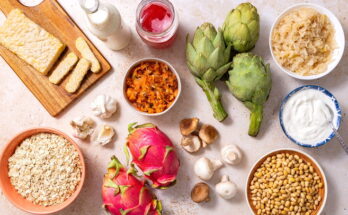Pizza Crust Recipe: If you’ve ever dreamed of biting into a crispy, golden-brown, yet chewy pizza crust made from scratch, this guide is for you.
Homemade pizza crust isn’t just about achieving a better taste than store-bought alternatives—it’s about creating a foundation for your favorite toppings.
Plus, the satisfaction of mastering this kitchen art? Unmatched. Let’s dive into this easy-to-follow recipe for the perfect pizza crust.
Ingredients for the Perfect Pizza Crust
Basic Ingredients List
To make the perfect pizza crust, gather the following staples:
- 2 ½ cups of all-purpose flour (or bread flour for a chewier crust)
- 1 cup of warm water (110°F/43°C, for activating yeast)
- 2 ¼ teaspoons of active dry yeast (one packet)
- 1 teaspoon of sugar (to help yeast activate)
- 1 teaspoon of salt
- 1 tablespoon of olive oil
Optional Ingredients for Flavor Enhancement
Take your crust to the next level by incorporating:
- 1 teaspoon of garlic powder for an aromatic boost.
- 1 teaspoon of dried Italian herbs (like oregano or basil).
- Grated parmesan cheese sprinkled into the dough for extra richness.
Essential Tools for Pizza Crust Making
Equipment Checklist
Here’s what you’ll need:
- A large mixing bowl for combining ingredients.
- Measuring cups and spoons for accuracy.
- A wooden spoon or silicone spatula for stirring.
- A rolling pin for shaping (or your hands for stretching).
- A pizza stone or baking sheet to ensure even baking.
Tips on Choosing the Right Tools
For optimal results, invest in a pizza stone. This tool absorbs moisture and distributes heat evenly, ensuring a crisp base. If unavailable, a sturdy baking sheet works as a reliable substitute.
Preparing the Dough
Activating the Yeast
Start by activating your yeast. In a small bowl, mix the warm water and sugar, then sprinkle the yeast over the top. Let it sit for 5–10 minutes until it turns frothy. This step is crucial for ensuring your dough rises well.
Mixing the Ingredients
In a large mixing bowl, combine your flour and salt. Gradually add the yeast mixture and olive oil. Stir the mixture until it starts to come together into a shaggy dough.
Kneading the Dough
Transfer the dough to a lightly floured surface and knead for 8–10 minutes. Use the heel of your hand to push the dough away, fold it over, and repeat. This process develops the gluten, giving your crust its signature chewiness.
Allowing the Dough to Rise
Place the kneaded dough in a greased bowl, cover with a damp towel, and let it rest in a warm spot for 1–2 hours. The dough should double in size, becoming airy and elastic.
Shaping the Pizza Crust
Punching Down the Dough
Once the dough has risen, gently punch it down to release excess air. This ensures an even crust without large bubbles.
Rolling or Stretching the Crust
Dust your work surface with flour and shape the dough into a ball. Roll it out with a rolling pin for a thin crust or stretch it by hand for a rustic, artisanal look.
Docking the Dough
Use a fork to poke small holes across the crust. This step prevents large bubbles from forming during baking and ensures an even texture.
Baking the Crust
Preheating the Oven
Set your oven to its maximum temperature, ideally between 475°F and 500°F (245°C to 260°C). A hot oven is essential for mimicking the intense heat of a pizza oven, giving you a perfectly crisp crust with a chewy interior. Place your pizza stone or baking sheet inside as the oven preheats to ensure it’s piping hot when the dough goes in.
Blind Baking vs. Fully Topping the Pizza
Depending on your recipe, you may want to blind bake the crust. Blind baking involves pre-baking the crust for about 5–7 minutes before adding toppings, which helps prevent a soggy center. For most pizzas, you can skip this step if you’re confident your toppings won’t over-saturate the dough.
Customizing Your Crust
Adding Herbs and Spices
One way to elevate your crust is to incorporate herbs and spices directly into the dough or sprinkle them on the edges before baking. Popular choices include:
- Dried basil, oregano, or thyme for a Mediterranean flair.
- Crushed red pepper flakes for a hint of heat.
- A sprinkle of garlic powder for an aromatic twist.
Stuffed Crust Options
Want to take it up a notch? Create a stuffed crust by folding shredded mozzarella or string cheese into the edges of the dough before baking. Pinch the dough tightly around the cheese to seal, ensuring gooey goodness in every bite.
Common Troubleshooting Tips
Dealing with Sticky Dough
If your dough sticks to your hands or work surface, add small amounts of flour while kneading. Be cautious not to add too much, as this can make the crust tough. Instead, aim for a slightly tacky texture that’s easy to handle.
Fixing Tough or Dense Crusts
A dense crust can result from over-kneading or insufficient proofing. Be gentle with your dough and ensure it has enough time to rise and develop air pockets.
Preventing Burnt Crust Edges
To avoid charred edges, cover the outer rim of the crust with foil halfway through baking. You can also brush the edges with olive oil or butter to promote even browning.
Storing and Reusing Pizza Dough
Refrigerating the Dough
If you’re not baking immediately, refrigerate the dough for up to 3 days. Wrap it tightly in plastic wrap or place it in an airtight container to prevent it from drying out.
Freezing the Dough
For longer storage, divide the dough into portions, wrap each one tightly in plastic wrap, and freeze for up to 3 months. Label the portions with the date for easy tracking.
Reviving Frozen Dough
Thaw frozen dough overnight in the refrigerator or for a few hours at room temperature. Once thawed, allow it to rest for 30 minutes before shaping to regain elasticity.
Tips for Achieving the Perfect Crust
Using a Pizza Stone or Steel
A pizza stone or steel mimics the intense heat of a traditional pizza oven, creating a beautifully crispy bottom. Preheat the stone or steel in the oven for at least 30 minutes for best results.
Experimenting with Flours
Different flours yield different textures. Bread flour creates a chewier crust, while all-purpose flour delivers a slightly softer bite. For an ultra-crisp base, try mixing in semolina flour.
Hydration and Texture Balance
Water content in your dough plays a key role in texture. A well-hydrated dough produces a light, airy crust. Start with the recommended measurements, but adjust as needed to account for humidity or flour variations.
FAQs about Pizza Crust Recipe
1. What ingredients are needed for a basic pizza crust?
A basic pizza crust requires flour, water, yeast, sugar, salt, and olive oil. For a richer flavor, you can add optional ingredients like garlic powder or Italian seasoning.
2. How long should I let the pizza dough rise?
Let the dough rise for at least 1-2 hours in a warm place until it doubles in size. For enhanced flavor, consider refrigerating it overnight for a slow fermentation process.
3. Can I make pizza crust without yeast?
Yes, you can make a yeast-free pizza crust using baking powder or Greek yogurt as leavening agents. These alternatives provide a quick and easy option.
4. How do I make the crust crispy?
For a crispy crust, preheat your oven and pizza stone to a high temperature (around 475°F or 245°C) before baking. Brushing the edges with olive oil also helps create a golden, crunchy texture.
5. Can I freeze pizza dough?
Absolutely! After the dough rises, divide it into portions, wrap it in plastic, and freeze. Thaw in the refrigerator overnight before use.
6. What’s the secret to a chewy pizza crust?
Using bread flour instead of all-purpose flour creates a chewier crust due to its higher protein content. Also, avoid over-kneading the dough to maintain its elasticity.
7. Can gluten-free pizza crust be made at home?
Yes, gluten-free pizza crust can be made using gluten-free flour blends, almond flour, or even cauliflower as a base. Ensure you add xanthan gum for better texture if it’s not already in the flour mix.
Conclusion
Making pizza crust from scratch isn’t just a recipe; it’s an experience. From kneading the dough to watching it rise and crisping it up in the oven, every step brings you closer to creating your perfect pizza. Plus, you can customize it to suit your taste, making every bite uniquely yours. So why settle for takeout when you can enjoy the aroma, taste, and pride of homemade pizza crust?



